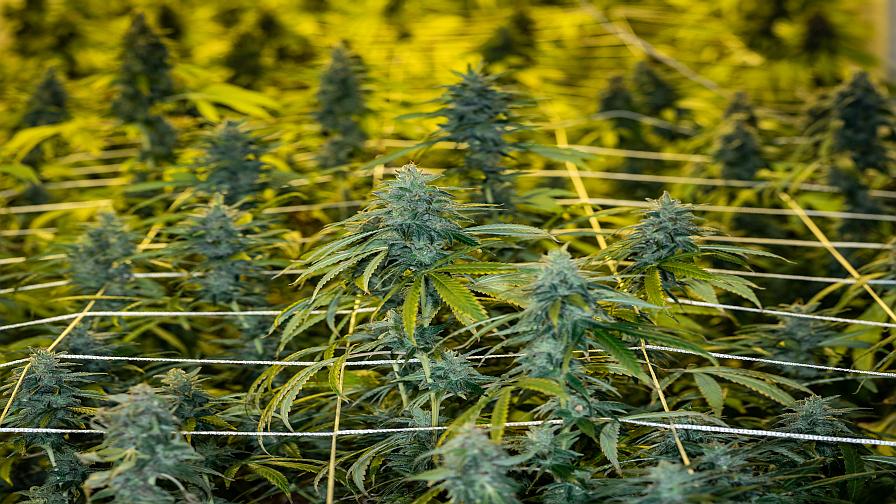Q&A: Why Cannabis Odor Control Should Be Considered Early On

Photo Credit: Instagram User “@daves_not_h3r3_man”
Perhaps not as intellectually stimulating as sorting through LEDs or browsing the millions of strains of cannabis genetics to find that next big greenhouse bumper cultivar, nevertheless it is incredibly important that growers keep odor control technologies in mind when planning that next facility expansion or grow room build-out.
Surna (Boulder, CO) is one of a handful of industry leaders helping greenhouse growers design their facilities to ensure odors and Volatile Organic Compounds (VOCs) are properly handled so that nearby neighbors and municipalities don’t come knocking at the facility gate. The Surna blog itself should be considered essential reading for any grower looking to learn more about odor control and HVAC considerations in fully controlled environment and greenhouse growing.
Brandy Keen is Surna’s Co-Founder and senior technical advisor, and she writes a good chunk of the content on Surna’s blog herself. I reached out to Keen with a few questions about odor control and HVAC in greenhouse cannabis production, as admittedly it is an area in which I still have some learning to do.
GreenhouseGrower.com (GG): Looking through the Surna blog, I learned that facility design is a big component of cannabis odor control for growers. Specific to growing in a hybrid greenhouse, where the facility is not 100% sealed to outside air, what are some best practices in facility design that growers should be aware of when it comes to odor control in the greenhouse?
Brandy Keen (BK): “When you are working with a building that uses ventilation as a major component to climate control, the most important thing for managing odor is to know the mechanism by which, and location where, air is leaving the facility. Any air leaving the facility is going to contain terpenes and VOC’s laden with odor.
“We’ve seen HVAC design vary pretty dramatically from greenhouse to greenhouse, and most hybrid facilities use a combination of ventilation and mechanical cooling to manage the greenhouse parameters. Often, these systems are provided by the greenhouse manufacturer, and sometimes they’re stand alone systems designed by a third party like Surna. In either case, it’s important that the owner instruct the designers to specifically consider odor control in their mechanical design and to identify clearly for the owners where odor control application will be most critical, and include it in the mechanical design were applicable.
“If the greenhouse manufacturer is providing climate control equipment but not odor control, it would be prudent to engage with a third party mechanical engineer to assist with identifying the sources of odor escape to assist with mitigation. It’s also helpful to ask questions of the manufacturer around the quality of greenhouse construction. The higher the quality of construction, the lower the odds of odor escape through nooks and crannies (or areas other than the ventilation system.”
GG.com: I understand that Surna advocates a focus on odor control in the early planning stages of a new build, versus the act of retrofitting existing structures for odor control. How did Surna come to advocate this approach? I assume there were some difficulties in the later?
BK: “Several years ago the City of Denver required that cultivators submit an odor mitigation plan to the city for approval. We had a number of existing cultivators reach out to us to draw up their odor mitigation plans. As part of that process, we had to evaluate what they had onsite and how their HVAC and ventilation systems were designed. We found that so many of those cultivators could have saved a lot of time and money having addressed odor mitigation at the mechanical design stage, as opposed to band-aiding and retrofitting what they already had.”
GG.com: Is there a delicate balance between odor control/mitigation, and ensuring your cannabis is fragrant and elicits the sensory experience that cannabis consumers prefer? I’ve always heard that if you eliminate all odors in an indoor grow that the “nose” of your final product will suffer? Is this true, or just a myth that still hangs around from the black market days?
BK: “That’s a great question, and if you find someone who can answer it through science and not opinion or anecdote, I’d love to meet them! In all seriousness though, odor filtration systems are removing terpenes and VOC’s from the air. So, it stands to reason that removal of terpenes would result in diminished aroma. We assume that this question is related to odor filtration in active cultivation or drying rooms and not ionization or oxidation, as those processes will directly impact the odor of the product as they’ll oxidize anything on a surface as readily as they’ll oxidize airborne particulate. (Although high density ionization or oxidation are a great strategy for removing odors from exhaust air at high volume, as well as for biosecurity and sterilization at carefully managed densities).
“We’ve also found that “in room” or recirculating odor control isn’t particularly effective anyway, unless the source of the odor is removed first. In a room where the odor is constantly being renewed it’s a losing battle to filter odor. So we really focus on managing the odor of the air leaving the building, or transition areas like offices and hallways, and not so much the source of the odor. This design strategy has proven to be effective.”
GG.com: Tell us about Surna’s most in demand odor control technologies or products for greenhouse growers. How does this product or products help a grower stay below the radar on local odor control regulations?
BK: “Carbon filtration is a tried and true strategy but must be vigilantly maintained and perfectly sized for the volume of air that’s leaving the facility. In some very large scale greenhouses this isn’t the most feasible strategy in but in smaller facilities it can work well. Ozone or other oxidation or ionization strategies applied in the air stream are very effective and most common on large scale facilities, again assuming the application densities are appropriate for the volume of air leaving the facility.”
(EDITOR’S NOTE: Want to learn more about odor control and HVAC strategies for greenhouse cannabis? Stay tuned to GreenhouseGrower.com in the coming weeks for the release of our upcoming Cannabis Whitepaper download featuring more in-depth information on HVAC strategies for greenhouse production, what VOCs are and why they must be managed, and more!)









